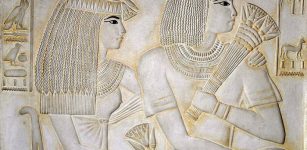Focus On Unique And Spectacular Gallery Grave In Ancient City Of Dara, Mardin
Conny Waters - AncientPages.com - In 2010 excavations of the ancient city of Dara in southeastern Mardin province, archaeologists unearthed a 1,500-year-old mass grave.
Dara - located in the border area, just 7 km from the Turkish-Syrian border - is considered one of the most important settlements in Upper Mesopotamia, and the gallery grave where hundreds of people were buried together is a very unique place.
 Gallery grave in the ancient city of Dara, Mardin. Image credit: ntv.com.tr
Gallery grave in the ancient city of Dara, Mardin. Image credit: ntv.com.tr
At the entrance of the site where hundreds of bones and skulls have been unearthed, there are symbols depicting Jesus Christ and Orthodoxy.
One of Dara's neighbors in ancient times was the Persian Sassanid Empire, and in the early Byzantine times, Dara was an important fortress. Because of this strategic location, in the 6th century AD, Dara witnessed many military conflicts. One of these conflicts was particularly significant and it was the famous Battle of Dara, fought in 530 AD.
Associate professor Hüseyin Metin, head of the excavation committee of the ancient city of Dara and a lecturer at the Department of Archaeology of Kafkas University, said what distinguishes this mass grave from other ancient tombs is the presence of human bone fragments, writes Daily Sabah.
 A general view of the ancient city of Dara, Mardin, southern Turkey, Aug. 20, 2020. Image credit: DHA
A general view of the ancient city of Dara, Mardin, southern Turkey, Aug. 20, 2020. Image credit: DHA
Now, the entrance of the site has been enclosed by a glass facade and a walking platform for tourists and locals who are now able to comfortably and conveniently visit this ancient place.
“The place called the gallery grave is one of the areas that attract the greatest number of visitors. After Byzantine Emperor Anastasius I decreed it as a garrison city, these areas were first used as the fortifications of the city and as a quarry for public buildings, said Professor Metin.
He also added that "after a large area was created at the site, certain sections were used as grave structures. These grave structures are of a different nature."
The tombs were carved into the rocks and on three levels, in this fenced-off necropolis. Many of them have a very simple form, however, several others belonging to wealthy citizens, focuses the attention of the visitors with their spaciousness and decorations. On some tombs, there are both decorations and inscriptions.
 Bones lie beneath a glass platform at the ancient city of Dara, Mardin, southern Turkey, Aug. 20, 2020. Image credit: DHA
Bones lie beneath a glass platform at the ancient city of Dara, Mardin, southern Turkey, Aug. 20, 2020. Image credit: DHA
The area featuring arcosolium (recessed) tombs, simple cists, and a gallery grave structure is unique, according to Metin, but the origin of the human bones in the double-story structure has not been entirely explained.
There are many theories regarding the gallery grave of Dara, and one theory proposes that the area - created in the sixth century - was a mass cemetery site built by Romans for the rites of resurrection in the Christian faith.
 Image credit: DHA
Image credit: DHA
Metin said that some views suggest that that the bones kept in sarcophaguses at that time were transferred to the lower part with the burials and that the soldiers who died in the Persian-Sassanid war in 530 were buried here in mass graves.
“What distinguishes Dara from all other ancient cities is the structure called the gallery grave. There are various descriptions of Jesus Christ, that is, Orthodox belief, at the entrance of the tomb. Inside, there is a double-story structure. There are various death beds in the form of coffins on the upper floor,” Metin stated.
Archaeological studies were able to shed light on the city of Dara, which was founded as a garrison city in 507 with the initiatives of Roman Emperor Anastasius I (491-518). The Emperor wanted to protect the eastern border of the Eastern Roman Empire against the Sassanids and the city was surrounded by a 4-kilometer-wall built from blocks transported from the nearby quarries.
Thus, Dara was the city, built as an 'inner castle'. Among the ruins of Dara, there are bastions, cisterns, residences, water canals, a church, a palace as well as agora (bazaar), a water tank (maxem), and water dams.
Dara was one of Mesopotamia's most important trade centers for centuries, and among others, it witnessed the war between Persian Emperor Darius and Alexander the Great. It was also captured by the Persians, and then, Dara came under the domination of the Umayyads towards the end of the 7th century, then the Abbasids, and the Ottomans in the 15th century.
The city's ruins tell its history.
Written by Conny Waters - AncientPages.com Staff Writer





















